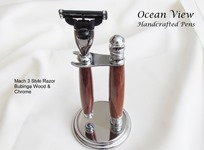About Us
I am an artisan living in Texas but spent many years in southern California. My small workshop in Palos Verdes had an ocean view which inspired the name of this website. I have been involved with woodworking in one form or another for the last 30 years or so. I experimented with turning pens a while back and have been hooked ever since. I just love watching the wood transform from some something rough into a beautiful work of art, particularly when the wood has been paired with the perfect styling and hardware.
There is no shortage of pen makers on the market today for you to choose from. I have turned hundreds of pens and I sold them to customers all over the world. Unlike some others, however, I don’t operate a pen-turning “factory.” Pen turning is my passion, but I consider it as my second job. That means I have the luxury to focus my passion on devoting the proper amount of time, care, love, and dedication to deliver beautiful and quality pens for my customers. This includes taking the time to select the best species and grade of wood as well as the best pen style and hardware. I therefore only turn a few pens at a time and choose to keep a smaller, select inventory of higher-end writing instruments with bold looks and styles.
My production technique
I hope the following will help you understand my approach when making my pens. The entire process takes me several hours, but it results in a unique work of art. When shopping for your special pen, I would encourage you to ask the seller where and how the pen is produced. Then compare whether they have invested the same amount of time and care into their writing instrument–particularly with the pen’s finish (see below)–as I do.
Choice of Wood or Material
The choice of wood is hand selected by me, and usually “speaks” to me when I imagine the wood’s color and grain pattern paired with the perfect pen style and hardware. When possible, I always select “exhibition grade” wood, i.e. only the most select cuts of the species. (For an overview and image of the the woods a use, visit the Sample Wood Species page). Alternatively, I may use acrylic, antler, or polymer clay to define the pen. Each requires a somewhat different approach, turning technique, and finishing process.
Pen Styles
There are probably dozens of pen styles to choose from. I choose those that feel good in the hand, that in my opinion have a bold or unique look, and those that have proven quality to remain durable and operable over the years. Again, the style of the pen must compliment the wood, and vice verse.
Turning the Pen
The material is turned one at a time by me on a lathe. I first and foremost remember that a pen must be functional and feel right in the hand. However I do often let my artistic juices flow, and I will choose a cut or shape that I feel best suits the wood and hardware yet will still allow its owner to comfortably write with and enjoy the pen. I use no duplication machinery, which guarantees that each finished pen is unique.
Finishing the Pen
Once the body of the pen has been shaped, the finishing process may begin. This is usually the most time consuming part of the process. Each pen, depending on the material, generally receives 16 sanding applications with progressively finer grit starting from 180 and finishing up with 12,000 grit with Micro Mesh pads. The material must be cleaned between each sanding application. At this time the wood or material will have already achieved a beautiful shine.
After the sanding is completed, I then begin the protective finishing process. There are many products available to finish wood including friction polish, laquer, and CA (Cyanoacrylate). I use the CA finish on wood, as it leaves a mirror finish, polishes well, and is very durable and stands up to scratches. This CA finish is a difficult process to master, and it is an important distinction when compared to other pen turners who use only, say, a friction polish to finish to wood. That process is generally easier, quicker, and cheaper. However, with a friction polish finish, the oils present in your fingers and hand may penetrate the polish and will dull or darken the wood’s color over time. Since I apply 6 separate layers of CA, however, the resulting finish is durable, glass-like, and will keep the wood’s luster for years to come. (That said, some customers do prefer the touch and feel of more wood over the CA finish; therefore, I do produce and offer some pens finished with a friction polish and a protective cream or wax).
After the CA finish is applied, then the final sanding and polishing starts. I usually wet-sand the CA finish with progressively finer Micro Meshs pad with grits between 1,500 to 12,000. Then the pen is polished yet again with another product to enhance its luster and beauty.
That’s a lot of sanding and polishing, but well worth it since the end result is a beautiful, durable work of art that will be treasured for generations.
Thank you for visiting, and please contact me if you have any questions or comments!
Paul Boodée



